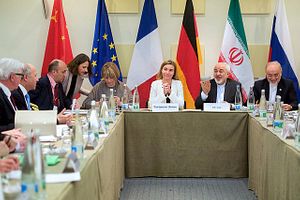The joint statement issued on April 2 in Lausanne did not lie—earlier that day, the EU High Representative, the Foreign Minister of Iran and the six other parties to the negotiations on Iran’s nuclear programme did take a “decisive step” towards ensuring the exclusively peaceful nature of that programme.
Their primary instrument will be the nuclear inspectorate of the International Atomic Energy Agency (IAEA). Iran has offered to grant the IAEA unprecedented access to its programme. Iran will re-apply the Additional Protocol, a legal norm which allows the IAEA to acquire information about, and access to, a wide range of declared or suspected nuclear sites. Iran will also allow the IAEA access to the workshops, where key components of its centrifuges (for enriching uranium) are manufactured, as well as to centrifuge assembly and storage sites.
These provisions will make it extremely hard for Iran to escape detection in the most unlikely event that its leaders were tempted to build a secret enrichment facility to produce uranium enriched to weapon-grade (HEU).
The other “solutions” agreed to on April 2 are designed to address other concerns that have exercised the U.S. and EU during the 12 years since the IAEA discovered that Iran had been pursuing a “policy of concealment” and failing to declare to the IAEA its R&D into enrichment technologies and plutonium separation.
An international joint venture will assist Iran to redesign and rebuild a reactor at Arak, to minimise the amount of plutonium that could be separated from spent fuel, were Iran to build a reprocessing facility—which it has re-affirmed it has no intention of doing.
An underground facility at Fordow, which can house 3,000 centrifuges, will no longer be used for enriching uranium. It will be converted into a nuclear physics and technology centre.
At a much larger enrichment facility near Natanz, centrifuge numbers will be cut to just over 5000, and there will be restrictions on potential feed material. These measures are designed to ensure that Iran will require at least a year to “break out” and produce enough HEU for one weapon—were the improbable decision taken to use an IAEA-safeguarded facility to breach Iran’s commitments under the Nuclear Non-Proliferation Treaty (NPT).
The development of more efficient centrifuges than those that will be in use at Natanz will be constrained by restrictions on Iran’s centrifuge R&D activities for at least 10 years.
The U.S. likes to characterise all these measures as ways of closing potential “pathways” to a nuclear weapon. America’s zeal in this respect, which at times must have tried the patience of Iran’s negotiators, has to be understood in the context of the opposition which the final agreement (with a deadline of June 30) will face in Congress.
Whipped on by the prime minister of Israel, a large number of U.S. senators, concerned about maintaining a flow of campaign contributions from pro-Israeli donors, are readying to capsize the final agreement, if they can. To overcome their opposition President Barack Obama will need to be able to assure the American people that his negotiators have denied Iran “all pathways” to nuclear arms for well over a decade.
Of course, opponents will counter that Iran is merely biding its time and will embark on a nuclear weapons programme once all restrictions are lifted.
In response at least two points can be made:
- Since late 2007, the U.S. has known that Iran’s leaders are not decided on becoming nuclear-armed, and that their decision-making is influenced by cost-benefit calculations. Over 10 years a nuclear agreement can reduce what little incentive Iran’s leaders have to incur the political, economic, and security costs of violating the NPT;
- It is not inevitable that Iran will expand its enrichment capability, thereby shortening the potential break-out time, once restrictions lapse. In November, Iran agreed with Russia’s Rosatom that Rosatom would build several reactors in Iran and meet their life-time fuel needs. The 10 years of international nuclear cooperation that the April 2 statement envisages will give the U.S. and EU ample opportunity to convince Iran of the benefits of sourcing reactor fuel abroad, or creating an international joint venture for fuel supply.
The negotiators now have three months to work through the details of the “solutions” which were announced on April 2. The sequencing of the relief from sanctions by the UN, EU and the U.S. that is due to Iran, in return for the above confidence-building derogations from its rights under international law, will be problematic.
But it will be surprising if the parties, having got so close, fail to complete their journey. Bringing sanctions to an end will benefit European companies, whose exports to Iran are a quarter of what they were a decade ago. Eliminating a potential source of conflict in a sensitive region is an important prize. Setting U.S.-Iran relations on a path to détente is long overdue, even if the path is likely to prove stony.
Ambassador Peter Jenkins is a former British diplomat who worked on the Iranian nuclear issue when ambassador to the International Atomic Energy Agency in Vienna (2001-06). This article was originally published at Gateway House: Indian Council on Global Relations, a foreign policy think tank in Mumbai, India, established to engage India’s leading corporations and individuals in debate and scholarship on India’s foreign policy and the nation’s role in global affairs.

































